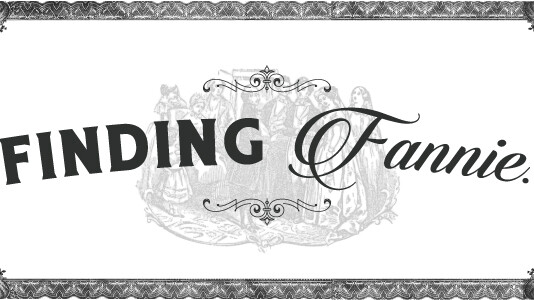Essay: Finding Fannie
on an obsessive journey, Eau Claire writer B.J. Hollars roams from antique shop to headstone
BJ Hollars, photos by BJ Hollars, Andrea Paulseth |

![]()
While antiquing one day in Eau Claire, author B.J. Hollars came across a wedding certificate belonging to a Fannie H. Ingram. Driven by no more than obsessive curiosity, Hollars retraced her steps, stopped at her family’s home — and even found her final resting place — but is it all just one big dead end?
![]()

![]()
Our story begins on a Tuesday in June while antiquing in Eau Claire. I’ve dedicated the afternoon to browsing, wading through the dust-caked taxidermy and the brittle books until I stumble upon a binder on a shelf full of binders and begin flipping through the plastic sleeves.
Here is a playbill, a handbill, letterhead for a man long dead.
Everything, I think, is biography.
Eventually, my eyes steady upon a marriage certificate issued to Benedict R. Schwahn and Fannie H. Ingram on June 5, 1922.
Their names mean nothing to me, which is perhaps why I’m compelled to know them better.
I wonder: How close can you get to people you’ve never even known?
I unclasp the sleeve and walk to the register, purchase proof of their love for two dollars.

That night, I bring them back to life the best I can: scouring every local newspaper report that makes mention of a Schwahn or an Ingram. The Schwahns offer few clues – Benedict’s published life is reduced to his classification by the local exemption board – though the Ingrams fill pages of the local paper, patriarch Orrin Henry Ingram, in particular.
In the winter of 1856, Orrin – Fannie’s grandfather – traveled west to make his fortune in the trees. Over the years he’d gained extensive knowledge of millwork, and after observing the white pines stretched throughout Eau Claire, he decided to call this place home.
For the next 50 years, the landscape changed all around him, trees felled and rivers glutted as the lumber industry boomed. Orrin played a direct role in these changes, paring back the wilderness so his town – and his profits – could grow.
All of this is recorded in Orrin’s business records – 20 or so cubic feet of which are housed at UW-Eau Claire’s archive. I’ve been reading them for days, scanning every ledger of every column in search of some mention of Fannie.
But there is no mention of her, and why should there be?
These are business records, after all, and written in a time when Fannie was but a glimmer of a possibility. There was no trace of her because she was not yet there.
The clues to her life will come later.
![]()
Not long after acquiring the marriage certificate I park my car outside Fannie’s childhood home. It’s a 7,900-square-foot Colonial Revival on Third Avenue, just a short walk from the river where her grandfather once floated his logs.
The house was built in 1899, two-years after her birth: an 18-room structure complete with pillared porch, curved bays, and a chimney running the height of the house. It still stands, though it’s a shadow of its former self, its vastness now subdivided into six apartments, most of which I imagine are likely occupied by college students.
Marriage certificate in tow, I step from the car as a pair of coeds slip from the porch and wander toward the bars on Water Street.
What would these two do if I stopped them? I wonder. If I flagged them down to tell them all that I know about Fannie?
But what do I know?
That this is the house where Fannie wept when her father died too young?
The place where she slipped on her boots and coat before setting off to school?
I assume but cannot know that these porch steps are the same porch steps that once clapped beneath Benedict’s weight, that these pillars are the same pillars that once hid them in shadows.
None of this is confirmable in any record, though this hardly keeps me from dreaming their lives.
Or speculating their lives.
Or guessing their lives.
Or filling in their lives as I see fit.
![]()
One morning my wife walks into the basement to find me surrounded by Fannie and Benedict’s newspaper clippings.
She’s holding our newborn daughter, and her message is clear: surely, there’s a better use of my time.
“What is it you’re after exactly?” she asks me.
I tell her I don’t yet know.
As I watch them leave I wonder if Fannie was the kind of wife that might’ve asked that question.
What is it you’re after, my dear Benedict? Who exactly are you trying to find?
![]()
One day while retracing my steps in the archive, an assistant archivist asks, “Is it true you’re looking for information on Ingram?”
Fannie, I beg, and though she can’t promise me Fannie, she does promise me several boxes of Ingram family flotsam, all of which were donated the previous fall when Fannie’s childhood home was auctioned off.
The rabbit hole widens, but only for an instant.
As I begin studying each slip of paper, it becomes clear that none of the collection’s contents concern Fannie. Rather, everything in it once belonged to her uncle and aunt.
Still, I study the family’s grocery lists (coffee, sausage, celery, parsley, cheese) in the hopes of learning something new. When this leads me nowhere, I turn to her aunt’s corset receipts and her uncle’s magazine subscriptions.
I learn the name of their piano tuner and the cost of their Florida oranges.
I gather their details, spread them across the longest table I can find, and wait for Fannie to materialize.
But no matter how much I pull and press and rearrange, these artifacts offer no insight on my missing girl.
Everything, I think, is worthless biography.
![]()
June stretches into July but I am no closer to finding her.
I return to the newspaper reports, rereading every last mention of Fannie.
Like the less-than-riveting report that on May 22, 1920, she hosted a game of bridge.
And the equally mundane inch of newsprint dedicated to her visit to the Pacific Ocean.
But there is one previously overlooked news report that now matters to me, one that brings me closer to Fannie and Benedict than any other clue.
It’s a description of their wedding recounted in full in the Society section of the newspaper.
Upon reading it several times through, the image begins to emerge.
Suddenly I can see the wedding guests filing into First Congregation Church. It is nighttime (a Thursday in June), and the poplars and lilies are lit by candlelight. It is a balmy 64 degrees (prompting more shawls and overcoats than expected), though surely the bride’s face warms the room. Since Fannie’s father has passed, Fannie’s mother walks her down the aisle, handing her off to her soon-to-be husband while the Rev. L.A. Parr presides.
But first, maybe Fannie takes a moment to adjust the lace of her chiffon gown. Maybe she glances back at her train before tightening her grip on her bouquet of ferns and orchids.
I’ve yet to find a photograph of Fannie’s face, but I can imagine the veil that once graced it. And the orange blossoms that surrounded that veil, and the smile left obscured just behind it.
I reread the report until I hear the organist flood the room from the rafters on down. Reread it again until I hear the pews squeak as the guests rise, until the moonlight kaleidoscopes the stained glass and …
“Hey, I could use your help up here,” my wife calls.
I snap back to the present.
“Sorry, what?” I shout.
“I said I could really use your help up here,” she repeats over the sound of a crying child.
I shut the laptop and start up the stairs, the bride and groom close behind.
![]()

![]()
Why I didn’t begin my search at the Chippewa Valley Museum I’ll never know. Nevertheless, when I finally make it there by summer’s end, Fannie still waits patiently.
I bypass the exhibits on lumber and farm life and knock on the archive door.
“Hi there,” I say to the librarian. “Do you have a minute?”
I tell her what I’m after: Fannie – anything and everything on Fannie Ingram Schwahn.
The librarian nods, asks no questions, just types the name into an internal database.
A moment later, a pair of photos appears – both of Fannie on her wedding day.
I’m dumbfounded, tongue-tied.
“I … I’ve looked everywhere for her …” I mumble.
Of course I haven’t, and my failure to search for her in the most obvious place is enough to leave me flushed.
As the librarian disappears to retrieve the original photos, I begin to wonder if perhaps the wider search was necessary, if I needed to take the longer route to get the better view.
The librarian returns moments later, lays the photos before me and tells me to enjoy.
I reach for the first photo, then stare into the eyes of the woman I’ve been glimpsing for the past three months.
At last, she is more than my imaginings.
Though after studying the photo, it’s evident that she hardly fits the description I’d dreamed for her. She is no blushing bride, but a solemn-faced girl half-hidden behind her bouquet. The rest of her is draped in 90-inches of train, much of which swoops across her body like a spectral shroud. Benedict better fits my expectations – poker-faced and hardened, a true 20th century man.
I turn my attention to the second photo, this one depicting Fannie alone. She teeters on the bottom step of the staircase, though this time, a weak-smile floats across her face, thinning as it moves right to left.
Yet disappointedly, even after viewing Fannie’s photos, I feel no closer to her.
I thank the librarian for her time and start toward the door, but I don’t walk out – not yet.
“You know,” I say, “I’ve got to ask. Why keep her wedding photos? I mean, of all the people who’ve been married here over the years, why do you have hers?”
“We have them,” the librarian informs me, “because we have her dress as well.”
![]()
“As I hold the dress, I wonder if some part of her wanted to be found, or rather, if she wanted me to find some part of her. If she left clues behind so somepoor man with too much time on his hands might re-fashion her the best he could.”
![]()
Two days later, once the dress has been retrieved, the archivist walks me to a private room. She directs me to the table where the dress lays flat alongside a few of Fannie’s other possessions: her 90-inch train, her baby rattle, her sleigh bells.
The archivist hands me a pair of white gloves and leaves me to my work.
I am alone with Fannie for the first time, and unsure of what to do.
I begin by rattling the rattle, and almost immediately, baby Fannie appears. She’s brown-eyed and beautiful – the spitting image of my own daughter – and crawling atop the rug in her Third Avenue home. I watch her pound her rattle to the bottom step of the staircase like a judge gone mad with her gavel.
At least until her father appears and lift her in his arms.
There, there, he whispers, a prophecy: One day you’ll stand on this spot in your wedding dress.
I return the rattle to the table, then reach both hands toward the sleigh bells.
They sound like diamond raindrops, and upon being disturbed, release yet another sepia-toned scene. This time, I see a horse-drawn sleigh cutting grooves into the snowy Eau Claire night. And I see Fannie and her grandfather Orrin tucked alongside one another in the backbench of that sleigh. Just ahead of them are Fannie’s mother and father, Mary and Charles, singing merrily as the able-bodied horses rattle their bells.
I break my trance, return the bells, allow the dream to subside.

Finally, I turn to Fannie’s dress, running a gloved hand along its creamy material.
The dress retains the same yellow tint that appeared in the second photo.
Perhaps, I think, it was always this color.
I position the dress on a hanger and snap a few photos, then return it to the table alongside the train. Like magnets, the material reunites: three loose strands from the wedding dress attaching to three loose hooks from the train. I leave them be, wondering whose fingers were the last fingers to do what nature has just done.
I wonder also what compels a woman to save her wedding dress and toss her marriage certificate. Or – more likely – if someone else did the tossing.
What are you trying to tell me, Fannie? I think. What story do you want me to tell?
As I hold the dress I wonder if some part of her wanted to be found, or rather, if she wanted me to find some part of her. If she left clues behind so some poor man with too much time on his hands might re-fashion her the best he could.
I try imagining myself a hundred years in the past, a red-faced boy waving to a red-faced girl in the backseat of a horse-drawn sleigh. I try imagining us growing old together in our shared town, nodding to one another as we pass each other on the sidewalk, at the theater, at the beach. I imagine the conversations we might’ve had but didn’t, the hands of bridge we never dealt.
I unfasten the threads from the hooks, then straighten Fannie’s dress on the table.
As I leave the room the archivist asks if I found what I was after.
I tell her I think so.
“Good,” she says. “Glad we could help.”
I am also glad. But I am also something else – melancholy maybe, or just unready to return to the 21st century with Fannie’s marriage certificate in hand.
“Listen,” I say, reaching for the certificate in my backpack, “ I don’t know if there’s any historical significance to this, or if you’d even want it, but since the dress is here and her belongings are here, maybe …”
The archivist is too kind to smirk at my sentimentality, and she’s too kind to tell no.
“Thank you,” she says, reaching for a donation slip. “We’ll add it to her collection.”
![]()
Our story ends on a Wednesday in August while roaming Lakeview Cemetery in Eau Claire. The afternoon rain has raised the earthworms, and together, my two-year-old son Henry and I dodge their bodies as we splash in puddles alongside the paths.
It’s early evening, the sextant’s long gone, so we walk blindly through the grounds in search of Fannie.
I carry a dripping Henry for the first quarter mile or so, scanning the names embossed in stone and hoping for a Schwahn.
But the name that catches my eye is Ingram – a large, family monument impossible to miss. I walk closer, and sure enough, there are Fannie’s grandparents, Orrin and Cornelia.
And not far away, Fannie’s parents, Charles and Mary.
I know Fannie’s close – I can sense it – so I search frantically among the stones.
“What are we looking for?” Henry asks.
“A woman,” I say. “Daddy’s friend.”
“I help, too,” he offers, patting the tops of the graves.
Eventually, we find her midway between her grandparents and parents. Her marker is humble, nondescript, nearly identical to those all around her.
It reads simply:
FANNIE H
INGRAM
SCHWAHN
1897-1987
Benedict is buried to her left, and to the left of him, their son, Stephen.
I press my hand to Fannie’s name.
“You found your friend?” Henry asks.
I nod.
Henry pauses, puzzled: “But where is her?”
“Here,” I say, pointing to the marker.
“Inside?” he asks.
“Beneath.”
I’ve confused him, so I retry.
“This is the woman daddy’s been searching for. She was married to this man,” I say, pointing to Benedict’s marker. “They were married the way Mommy and Daddy are married.”
His brow furrows.
“And this?” he asks, tapping Stephen’s stone. “Who’s him?”
“This was their little boy.”
“Like me?” he asks.
I shudder.
“Hey look,” I say, pointing to the puddle ahead of us. “I think we missed one.”
We correct our error, sloshing past the graves until we’re ankle deep in muck. We jump, splash, cause enough ruckus to scare off all the geese. As they move toward the river I take Henry by the hand.
“Come on,” I say when we are the last ones left, “let’s go home. Momma misses us.”
“But why?”
“Because that’s what people do,” I say. “They just miss each other.”
Together, we drip a trail back to the van.
We disappear with a trace.






















